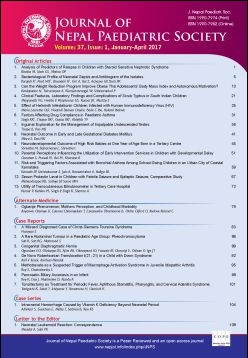Bacteriological Profile of Neonatal Sepsis and Antibiogram of the Isolates
DOI:
https://doi.org/10.3126/jnps.v37i1.16303Keywords:
Neonatal sepsis, Staphylococcus epidermidis, Escherichia coli, NepalAbstract
Introduction: Neonatal sepsis is a serious problem in developing countries like Nepal. The main objectives of this study were to determine the bacteriological profile of neonatal sepsis, to determine the antimicrobial susceptibility patterns of the causative agents and to evaluate the association between the neonatal sepsis and the different characteristics of the neonates.
Methods: A hospital based cross-sectional study was conducted among a total of 450 neonates suspected of suffering from sepsis. Blood culture was performed using statdard microbiological techniques. The colonies grown were identified on the basis of colony morphology, Gram’s stain and biochemical tests. The antimicrobial susceptiblility testing was performed by Kirby Bauer disc diffusion method.
Results: Out of total 450 blood samples, 92 (20.4%) were culture positive. Of which, 16 (17.4%) samples contained gram negative bacteria and 76 (82.6%) samples contained gram positive cocci. The most common bacterial pathogens isolated were Staphylococcus epidermidis (67.4%) followed by Escherichia coli (13%). All gram positive cocci were susceptible to vancomycin, while all gram negative bacilli were sensitive to amikacin. There was statistically significant relationship between neonatal sepsis and gestation age of neonates.
Conclusions: Neonatal sepsis is still present as a serious problem in Nepal. Staphylococcus epidermidis was the most common cause of the neonatal sepsis. Prematurely delivered neonates should be given more care, as they are more prone to suffering from neonatal sepsis. Vancomycin and amikacin can be used as the drugs of choice for preliminary treatment of neonatal sepsis in our settings.
Downloads
Downloads
Published
How to Cite
Issue
Section
License
Authors who publish with this journal agree to the following terms:
Authors retain copyright and grant the journal right of first publication with the work simultaneously licensed under a Creative Commons Attribution License that allows others to share the work with an acknowledgement of the work's authorship and initial publication in this journal.
Authors are able to enter into separate, additional contractual arrangements for the non-exclusive distribution of the journal's published version of the work (e.g., post it to an institutional repository or publish it in a book), with an acknowledgement of its initial publication in this journal.
Authors are permitted and encouraged to post their work online (e.g., in institutional repositories or on their website) prior to and during the submission process, as it can lead to productive exchanges, as well as earlier and greater citation of published work (See The Effect of Open Access).



